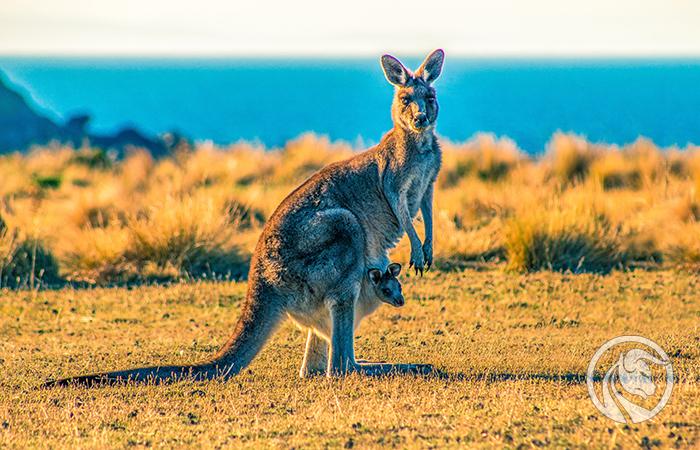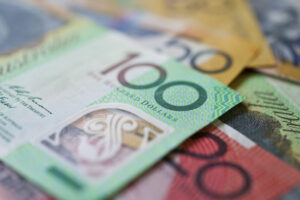AUD sparkles in the morning. Inflation in Australia continues to rise
We have recently become accustomed to the word disinflation, which means a decrease in inflation, but not a decrease in prices (not to be confused with deflation). Disinflation appeared in the euro area, in Poland and in the United States. However, there are countries where inflation continues to rise. One of them is Australia.
Today's figures may have been a surprise as Australia's annual inflation rate rose to 7,8%, the highest level since the early 90s. Thus, this may lead to increased expectations regarding further actions of the Bank of Australia and possible further interest rate increases. Recall that in December Reserve Bank of Australia raised the interest rate by 25 basis points to 3,1%. The move marked the eighth consecutive increase in interest rates, pushing borrowing costs to levels not seen since November 2012, the sharpest tightening since 1989. The Committee reiterated that the interest rate is not a fixed rate as the size and timing of future increases will continue to be determined by incoming data. The Council added that inflation in Australia would peak around 8% before weakening in 2023 and falling to just above 3% in 2024.
Inflation in Australia - detailed data
Higher prices of food, car fuels and new housing may have contributed to a further rise in inflation in Australia. Food prices rose the most since Q2006 9,2 (9,0% vs. 8,0% in Q9,2), while transport costs (10,7% vs. 10,5%), housing (XNUMX% vs. XNUMX%). As the portal continues TradingEconomics.com on a quarterly basis, consumer prices rose by 1,9% in Q1,8, following an increase of 2000% in Q6,9, marking the fourth consecutive quarter with a higher increase than at any time since the introduction of the Goods and Services Tax in 2003. Meanwhile, the RBA CPI rose XNUMX% year-on-year, the fastest since the beginning of the XNUMX series.
What's next for the AUD exchange rate?
In response to the publication of the data AUD / USD rate began to grow dynamically around the peaks of August 2022. At one point, the gain was above 1 percent, making the AUD the strongest currency of the morning.
#inflation in Australia does not slow down ↗️.
7,8 percent this is the highest reading since the early 1990s.AUD/USD up more than 1% this morning. to the highest level since August 2022.
*77% of clients lose when trading CFDs pic.twitter.com/BeuRc7HYPX
— CMC Markets Polska (@CMCMarkets_PL) January 25, 2023
From the point of view of the interest rate market, expectations about the actions of the RBA, which will announce its decision in the second week of February, have increased. After the euro, where the market expects the fastest growth rate in this half-year, the second is the AUD. The interest rate market seems to assume that there may be a total increase of 50 basis points in this period. It is worth adding that since the low of October 2022, the AUD/USD rate has climbed up by over 15%. without major adjustments. This may appear on the horizon in early February if the Fed convinces the market that it is serious about keeping interest rates at 5 percent. in 2023

AUD/USD chart, H4 interval. Source: next generation platform CMC Markets






















![Forex Club – Tax 9 – Settle tax on a foreign broker [Download the Application] Forex Club - Tax 9](https://forexclub.pl/wp-content/uploads/2024/02/Forex-Club-Podatek-9-184x120.jpg?v=1709046278)
![Trading View platform – solutions tailored to the needs of traders [Review] trading view review](https://forexclub.pl/wp-content/uploads/2024/03/trading-view-recenzja-184x120.jpg?v=1709558918)
![How to connect your FP Markets account to the Trading View platform [Guide] fp markets trading view](https://forexclub.pl/wp-content/uploads/2024/02/fp-markets-trading-view-184x120.jpg?v=1708677291)
![How to invest in ChatGPT and AI? Stocks and ETFs [Guide] how to invest in chatgpt and artificial intelligence](https://forexclub.pl/wp-content/uploads/2023/02/jak-inwestowac-w-chatgpt-i-sztuczna-inteligencje-184x120.jpg?v=1676364263)






![Izabela Górecka – “Success on the market depends not only on knowledge, but also on emotional stability” [Interview] Izabela Górecka - interview](https://forexclub.pl/wp-content/uploads/2024/04/Izabela-Gorecka-wywiad-184x120.jpg?v=1713870578)
![WeWork – the anatomy of the collapse of a company valued at $47 billion [WeWork, part II] wework bankruptcy story](https://forexclub.pl/wp-content/uploads/2024/04/wework-bankructwo-historia-184x120.jpg?v=1711729561)
![Adam Neumann – the man who screwed up Softbank [WeWork, part AND] adam neumann wework](https://forexclub.pl/wp-content/uploads/2024/04/adam-neumann-wework-184x120.jpg?v=1711728724)


![The most common mistakes of a beginner trader - Mr Yogi [VIDEO] Scalping - The most common mistakes of a beginner trader - VIDEO](https://forexclub.pl/wp-content/uploads/2024/03/Scalping-Najczestsze-bledy-poczatkujacego-tradera-VIDEO-184x120.jpg?v=1711601376)
![Learning patience: No position is also a position - Mr Yogi [VIDEO] Scalping - Learning patience - No position is also a position - VIDEO](https://forexclub.pl/wp-content/uploads/2024/03/Scalping-Nauka-cierpliwosci-Brak-pozycji-to-tez-pozycja-VIDEO-184x120.jpg?v=1710999249)
![When to exit a position and how to minimize losses - Mr Yogi [VIDEO] Scalping - When to exit a position and how to minimize losses - VIDEO](https://forexclub.pl/wp-content/uploads/2024/03/Scalping-Kiedy-wyjsc-z-pozycji-i-jak-minimalizowac-straty-VIDEO-184x120.jpg?v=1710336731)



















Leave a Response